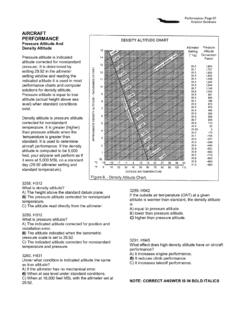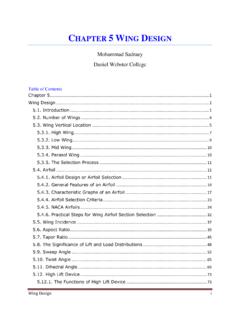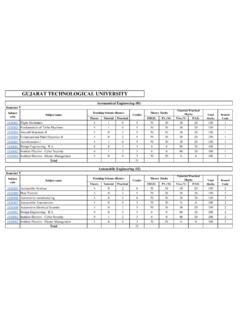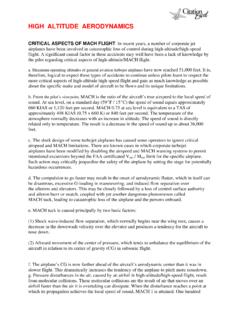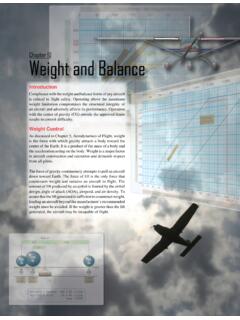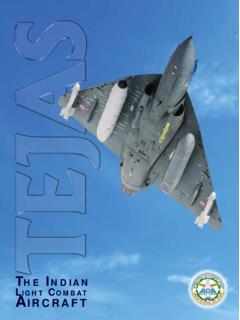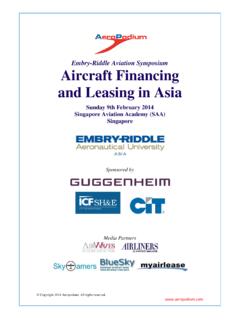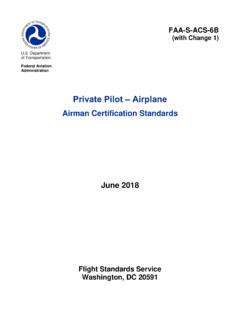Transcription of AERODYNAMICS AND AIRCRAFT OPERATIONS Definitions …
1 AERODYNAMICS and AIRCRAFT OPERATIONS Aviation Seminars 23. AERODYNAMICS AND AIRCRAFT OPERATIONS . Definitions Angle Of Attack And Stalling Speeds Angle of attack is the angle between the wing chord line and the direction of the relative wind. An increase in angle of attack will increase impact pressure below the The angle of attack at which a wing stalls remains wing to increase lift and drag, and will cause the center constant regardless of weight, dynamic pressure, bank of pressure to move forward. By changing the angle of angle, or pitch attitude.
2 Attack, the pilot controls the airplane's lift, airspeed and drag. There is a corresponding indicated airspeed required for every angle of attack to generate sufficient lift to Chord line is the line between the leading and the trailing maintain altitude. edges of the airfoil. Indicated stalling speed is increased by added weight, Relative wind is the direction of the airflow with respect increased load factor and bank angle, decreased power, to the wing. It is also the direction opposite and parallel and is most affected by variations in loading.
3 Turbulent to the flight path. air can cause an Increase in stalling speed when there is an abrupt change in relative wind. Forces Acting On The AIRCRAFT An airplane will spin only after having been stalled. If the CG is too far rearward, stall recovery becomes more difficult and normal spin recovery may become difficult. The airplane may become uncontrollable if the most rearward CG position is exceeded. Types Of Drag Drag is comprised of parasite drag and induced drag. As speed increases, parasite drag Increases and induced Lift is the differential pressure between the higher air drag decreases.
4 Pressure below the wing's surface and the lower air pressure above the wing's surface. It acts perpendicular The velocity Indicated by points A' and B' (on to the relative wind and flight path. next page) shows the maximum L/D speed (lift divided by drag). The maximum L/D speed decreases as weight Drag is the rearward force of wind resistance, and acts decreases. Maintaining maximum L/D speed will result in parallel to the relative wind. the maximum range and maximum distance glide. Thrust is the forward acting force, produced by the propeller.
5 It is equal to drag whenever your airspeed is constant: Lift equals weight whenever you are in straight and level flight, or climbing or descending at a constant rate. In steady-state flight (straight and level or steady climb or descent), the sum of the opposing forces is equal to zero. If airspeed is doubled and the angle of attack remains constant, lift and drag will be four times greater. AERODYNAMICS and AIRCRAFT OPERATIONS Aviation Seminars 24. Drag (Cont). Load factor is the actual load on the wings at any time divided by the weight of the airplane.
6 Load factor in a constant altitude turn depends strictly on The proper technique for crosswind takeoffs is to use angle of bank. As long as bank remains constant, load rudder as required to maintain directional control, aileron factor is also constant. pressure into the wind, and a higher-than-normal lift-off speed. During landing, the direction of motion of the If an airplane is listed as utility category, it can perform airplane and its longitudinal axis should be parallel to the limited acrobatics, including spins. runway. Functions Of The Flight Controls During gusty wind conditions, make a power-on approach and power-on landing.
7 Air Density High temperatures, high elevations, high humidity, and low atmospheric pressure result in lower air density and decreased performance. Uphill runway slope will increase takeoff distance. Regardless of altitude and air density, the indicated Elevators pitch the airplane about the lateral axis to airspeed at which an airplane stalls will remain the change the angle of attack. same. At higher elevations, the airplane will have a higher true airspeed, and a higher groundspeed at Rudder controls yaw about the vertical axis, not to turn touchdown.
8 The airplane, but to overcome adverse yaw produced by the depressed aileron on the high wing. Ground Effect Wing flaps increase lift and drag. This decreases stalling speed and increases the angle of descent during landing without increasing airspeed. Ground effect cushions the air beneath the wing, increasing lift and decreasing drag. An airplane leaving ground effect will experience an Increase in induced drag, require more thrust and a greater angle of attack. AERODYNAMICS and AIRCRAFT OPERATIONS Aviation Seminars 25. Stability Constant Speed Propellers (Cont).
9 Longitudinal stability (the nose pitching up or down) setting with low RPM. First Increase RPM, then manifold involves the motion of the airplane about the lateral axis. pressure. if the airplane center of gravity is to the rear of its range, the airplane will be unstable about its lateral axis. When decreasing power, first decrease manifold pressure, then RPM. If the airplane attitude initially tends to return to its original position after the elevator control is pressed Engine Cooling forward and released, the airplane displays positive static stability.
10 Engine cooling is caused by airflow and is especially dependent on the circulation of lubricating oil. An If the airplane attitude remains in a new position after the abnormally high engine oil temperature may be caused elevator control is pressed forward and released, the by the oil level being too low. airplane displays neutral static stability. Detonation occurs when the unburned charge (fuel) in AIRCRAFT AND ENGINE OPERATION the cylinders explodes Instead of burning evenly. Detonation may be caused by too lean a mixture. Propellers Preignition is the uncontrolled firing of the fuel/air charge Propeller efficiency is the ratio of thrust horsepower to in advance of normal spark ignition.


